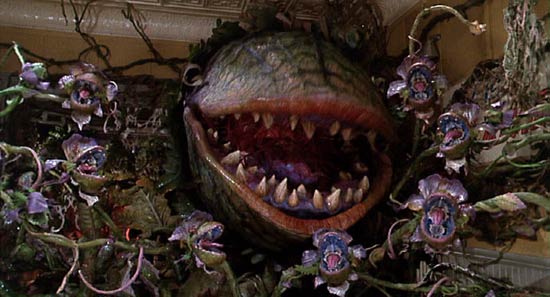In the pantheon of memorable movie monsters, pestiferous plantlife has to rank just about last. Vampires, werewolves, zombies, mummies, mad scientists and their creations, golems and other artificial men – all of these can lay claim to having appeared in numerous classic films. Yet how many horror movies featuring frightful flora and fiendish fungi achieve cult – let alone classic – status? 1960’s LITTLE SHOP OF HORRORS comes to mind, along with its 1986 musical remake. Both feature a giant, talking man-eating marigold that is played as much for laughs as frights, but at least the blood-thirsty bush is the star of the show. Other than that, one might cite the 1962 science fiction thriller DAY OF THE TRIFFIDS (in which Earth is overrun by sinister sprouts from outer space), but for the most part wicked weeds, violent vines, and savage shrubbery have been consigned to co-starring status, showing up for a scene or two in lost worlds, dark jungles, and strange islands, or making cameos in the laboratories of various mad scientists. With THE RUINS, the latest tale of heinous herbs, currently in theatres, we take a look at some of the more memorably malignant mutations of the vegetable world, and find that by stretching the distinction between flora and fauna, we can come up with two or three creepy classics.
ATTACK OF THE KILLER TOMATOES (1978). This silly spoof takes takes an intentionally ridiculous concept and milks it for joke after joke; whether they are funny or not is almost irrelevant, because the concept itself demands laughter. On the other hand, some viewers see this simply as another bad film, no better than the ones it spoofs. In retrospect, it comes across as a poor man’s AIRPLANE; a parody of sci-fi flicks in general, it just happens to have a killer plant as its monster.
AT THE EARTH’S CORE (1976). In this enjoyably unrealistic depiction of prehistoric life inside the Earth, a man-eating plant makes a brief appearance, interrupting a fight scene between the hero and an adversary. Needless to say, even though the two men had been trying to kill each other only minutes before, the hero saves his opponent from the clutches of the carnivorous creeping vine, and the two become fast friends, joining forces to defeat the evil Mahars that rule the underground world. Lost worlds and prehistoric civilizations seem to be disproportionately populated with pestilent plant life; similar shrubbery sprouts up in the 1960 version of THE LOST WORLD and in two Hammer Film productions, THE LOST CONTINET (1968) and WHEN DINOSAURS RULES THE EARTH (1971).
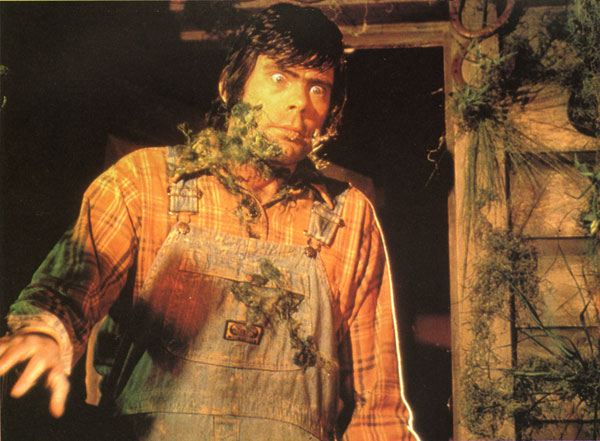 CREEPSHOW (1982). One episode of this five-part anthology film features a virulent form plant life: in “The Lonesome Death of Jordy Verrill,” Stephen King stars as the titular country bumpkin who cracks open a meteor and soon finds himself infected by some kind of fearful fungus. Unable to cure himself, Verrill commits suicide, but the plant life lives on, presumably spreading over the rest of the world.
CREEPSHOW (1982). One episode of this five-part anthology film features a virulent form plant life: in “The Lonesome Death of Jordy Verrill,” Stephen King stars as the titular country bumpkin who cracks open a meteor and soon finds himself infected by some kind of fearful fungus. Unable to cure himself, Verrill commits suicide, but the plant life lives on, presumably spreading over the rest of the world.
DAY OF THE TRIFFIDS (1962). This interesting movie, based on the novel by John Wyndham, portrays what left of life in England after a meteor shower leaves the majority of the population blind. It turns out that’s not the real problem; the real problems is that the meteorites have brought spores to Earth that sprout into ambulatory poisonous plants that threaten to take over the whole world. Fortunately for humanity, it turns out that the apparently invincible flora are actually susceptible to sea water – which proves as effectve on them as on the Wicked Witch of the West. There is also a 1981 TV series, which had the luxury of being more faithful to the source material.
DR. TERROR’S HOUSE OF HORRORS (1965). This early anthology from Amicus films contains five short stories that run the gamut of classic movie monster cliches: a werewolf, a vampire, voodoo, a crawling hand, and yes – a killer plant. There is little or no explanation for the vicious vine; it is simply noticed growing around an isolated house. Soon, it is snipping phone lines, strangling a hapless victim, and trapping the survivors in the house – until they learn that the wicked weed is afraid of fire, enabling them to escape. The final shot, of the vine batting out the flames left behind by the humans, leaves open the question of whether the plant is truly defeated.
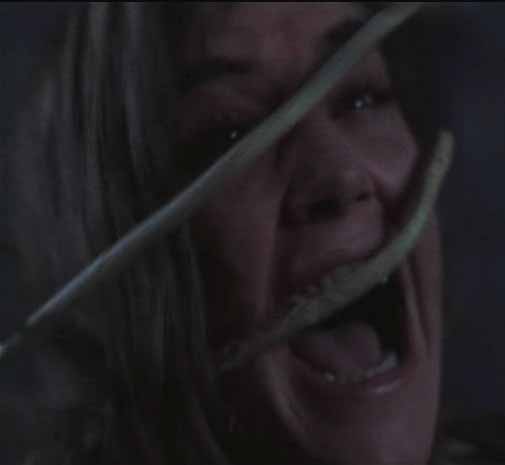 THE EVIL DEAD (1982)/EVIL DEAD II(1987). The 1982 originally features an almost deliberately offensive sexist scene wherein a female victim is – for all intents and purposes – raped by a sexually aggressive piece of shrubbery (imagery that may have inspired the “tentacle rape” sub-genre of Japanese anime). The 1987 “sequel” (which is more of a black comedy remake) features a milder version of the scene in which another female victim finds herself in the uncomfortable embrace of vicious woodland vegetation. This time, the sexual innuendo remains mostly innuendo (a few shots of torn clothing and a brief glimpse of a tiny tree limb inserting itself into the girl’s mouth). Progress of a kind, one supposes.
THE EVIL DEAD (1982)/EVIL DEAD II(1987). The 1982 originally features an almost deliberately offensive sexist scene wherein a female victim is – for all intents and purposes – raped by a sexually aggressive piece of shrubbery (imagery that may have inspired the “tentacle rape” sub-genre of Japanese anime). The 1987 “sequel” (which is more of a black comedy remake) features a milder version of the scene in which another female victim finds herself in the uncomfortable embrace of vicious woodland vegetation. This time, the sexual innuendo remains mostly innuendo (a few shots of torn clothing and a brief glimpse of a tiny tree limb inserting itself into the girl’s mouth). Progress of a kind, one supposes.
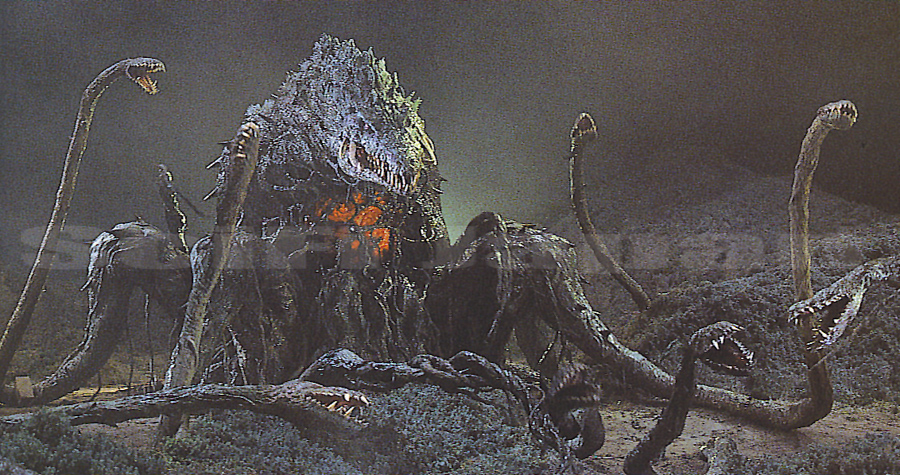 GODZILLA VS. BIOLANTE (1989). In the colorful piece of Japanese fantasy film-making, the famous radioactive dinosaur comes into conflict with a genetically mutated version of himself: a giant flower that resulted from a scientist’s efforts to resurrect his dead daughter, combining her DNA with that of Godzilla and a rose. Biolante (who, along with Audrey, is one of the few killer plants to earn a proper name) is one of Godzilla’s most fearsome foes, a mountain-sized poisonous plant, with numerous teeth and tendrils, that uproots itself for the climactic confrontation. The “science” of this science-fiction film is completely incredible, but the film hits the right fantasy note that makes its over-the-top ideas fun to watch.
GODZILLA VS. BIOLANTE (1989). In the colorful piece of Japanese fantasy film-making, the famous radioactive dinosaur comes into conflict with a genetically mutated version of himself: a giant flower that resulted from a scientist’s efforts to resurrect his dead daughter, combining her DNA with that of Godzilla and a rose. Biolante (who, along with Audrey, is one of the few killer plants to earn a proper name) is one of Godzilla’s most fearsome foes, a mountain-sized poisonous plant, with numerous teeth and tendrils, that uproots itself for the climactic confrontation. The “science” of this science-fiction film is completely incredible, but the film hits the right fantasy note that makes its over-the-top ideas fun to watch.
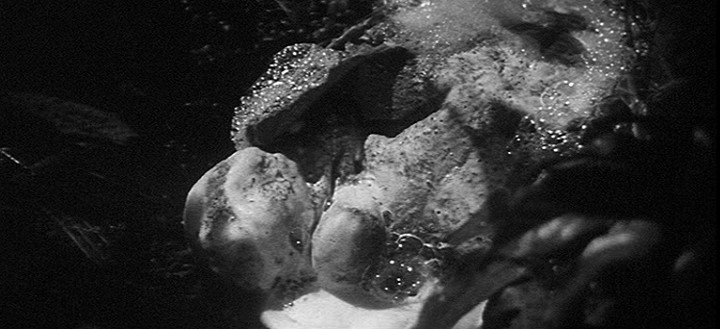 INVASION OF THE BODY SNATCHERS (1956, 1978). Jack Finney’s 1954 novel tells the tale of a small town called Santa Mira, where all the residents are gradually replaced by emotionless duplicates. It turns out that the replacements are grown from plant-like alien spores. The 1956 black-and-white classic, directed by Don Siegel (DIRTY HARRY), best captures the paranoia of the book, including a wonderfully eerie scene in which the spores are scene hatching duplicate bodies. The 1978 remake is good update of the idea, transplanting the story to a modern metropolis instead of small town America. A 1993 version, titled simply BODY SNATCHERS, less interesting, and the 2007 version THE INVASION does not qualify here, because it changes the menace from spores to a virus.
INVASION OF THE BODY SNATCHERS (1956, 1978). Jack Finney’s 1954 novel tells the tale of a small town called Santa Mira, where all the residents are gradually replaced by emotionless duplicates. It turns out that the replacements are grown from plant-like alien spores. The 1956 black-and-white classic, directed by Don Siegel (DIRTY HARRY), best captures the paranoia of the book, including a wonderfully eerie scene in which the spores are scene hatching duplicate bodies. The 1978 remake is good update of the idea, transplanting the story to a modern metropolis instead of small town America. A 1993 version, titled simply BODY SNATCHERS, less interesting, and the 2007 version THE INVASION does not qualify here, because it changes the menace from spores to a virus.
KONGA (1961). This 1961 English rip-off of KING KONG features a mad professor (Michael Gough) who invents some kind of serum that enlarges an ordinary chimp, first into a man-size gorilla and finally into a Kong-size monster. Working on the theory that that was not enough to keep an English audience properly horrified, the film also has the professor growing some sort of mutant Venus Flytrap in his hot house. While Konga runs amok at the climax, one of the professor’s female students has the misfortune of getting her arm trapped – a difficult thing to do, since the carnivorous cauliflower has no tendrils to draw her in. The film cuts away, leaving her fate uncertain but implying that she was devoured. Why she could not simply pull her arm free is unclear.
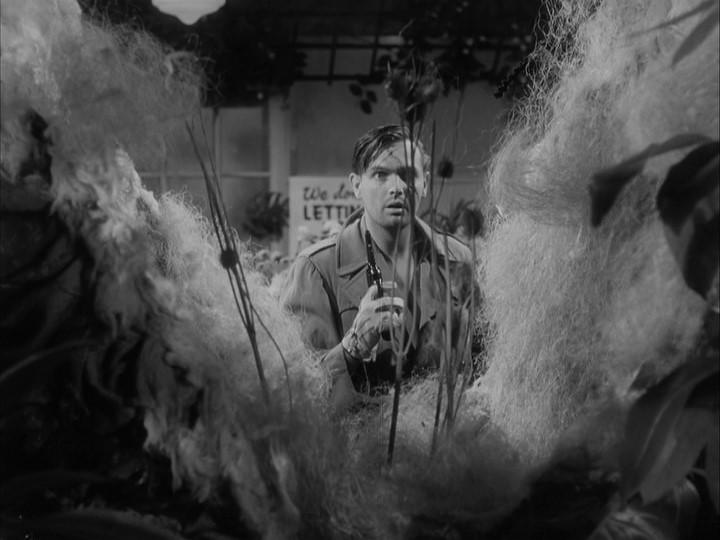 LITTLE SHOP OF HORRORS (1960 and 1986). Producer-director Roger Corman’s cult film, written by Charles B. Griffith, is famous for having completed principal photography in two days (actually, second unit work extended the schedule to nearly a week). It also gave the world Audrey, a talking blood-thirsty bulb created by Seymour (Jonathan Haze) and named after the girl he loves (Jackie Joseph). Seymour feeds Audrey drops of blood from his fingers, but when the plant grows too big, it ends up devouring whole humans. In one of the film’s funnier scenes, Seymour’s employer Mushnick (Mel Wells) fools an armed robber into searching for loot inside Audrey, with predictably lethal results. The whole film is too ridiculous for Audrey to be truly scary, but man-eating marigold is certainly quite a character, memorably demanding in an impatient, outraged voice, “Feed me! FEED ME!” The 1986 remake adds songs and bigger, better production values; it’s glossy and fun, but it lacks that low-budget independent charm that worked so well in the original.
LITTLE SHOP OF HORRORS (1960 and 1986). Producer-director Roger Corman’s cult film, written by Charles B. Griffith, is famous for having completed principal photography in two days (actually, second unit work extended the schedule to nearly a week). It also gave the world Audrey, a talking blood-thirsty bulb created by Seymour (Jonathan Haze) and named after the girl he loves (Jackie Joseph). Seymour feeds Audrey drops of blood from his fingers, but when the plant grows too big, it ends up devouring whole humans. In one of the film’s funnier scenes, Seymour’s employer Mushnick (Mel Wells) fools an armed robber into searching for loot inside Audrey, with predictably lethal results. The whole film is too ridiculous for Audrey to be truly scary, but man-eating marigold is certainly quite a character, memorably demanding in an impatient, outraged voice, “Feed me! FEED ME!” The 1986 remake adds songs and bigger, better production values; it’s glossy and fun, but it lacks that low-budget independent charm that worked so well in the original.

MATANGO (a.k.a. ATTACK OF THE MUSHROOM PEOPLE, 1963). This horror movie from Japan eschews the usual giant monster formula in favor of presenting a fascinating portrait of human de-evolution. In a set-up that prefigures the American TV show GILLIGAN’S ISLAND, seven people on a boating tour end up castaway on an uncharted island: there’s the skipper, the mate, the millionaire, the professor, and two women – one an sexy entertainer, the other a cute small-town girl; the only character not carried over to the show is a male journalist. With little other food available, they succumb to eating a radiated mushroom known as matango, the unfortunate side effect of which is that they begin mutating into fungus themselves. Inspired by William Hope Hodgson’s classic short story “A Voice in the Night,” the film uses the literal loss of humanity as a metaphor for what is happening to the characters: cut off from civilization and its constraints, they regress to more primitive, barbaric behavior. The mushroom makeup is probably scary only to very young viewers, but director Ishiro Honda keeps it mostly in shadows till the end; the real horror comes from watching the characters LORD OF THE FLIES-style descent.
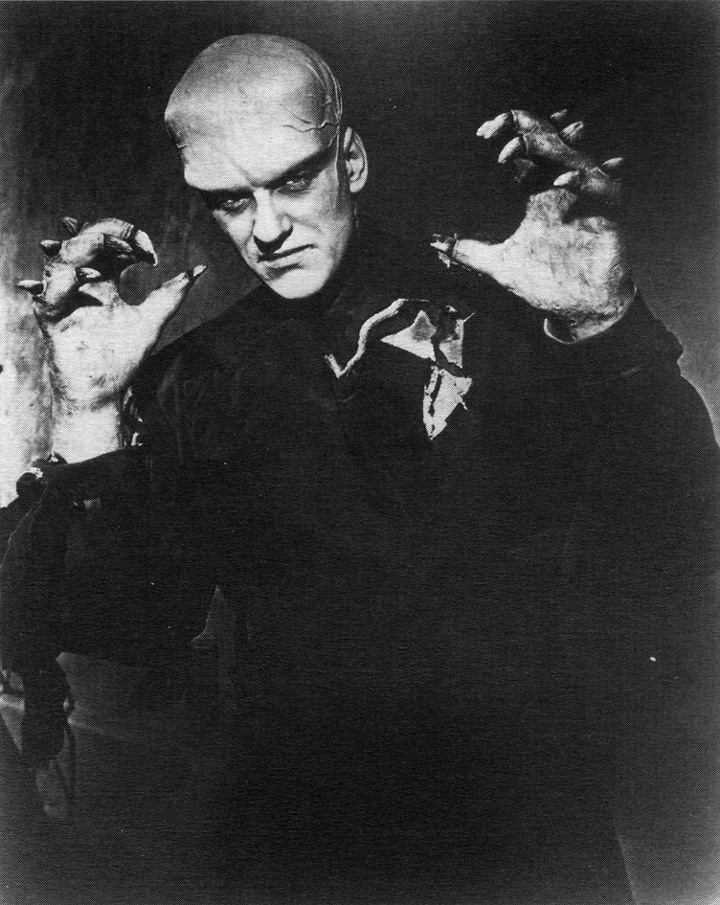 THE THING FROM ANOTHER WORLD (1951). This classic alien invasion film features a walking, hulking, blood-drinking vampire-creature from outer space with a squared-off head vaguely reminiscent of Frankenstein’s Monster – and yet the dialogue leaves us in no doubt that the alien is vegetable, not animal (“an intellectual carrot,” as one character observes). With its claustrophobic, isolated setting, this remains one of the greatest fright films ever, thanks to rapid-fire dialogue and a crafty approach to the alien, who is only briefly glimpsed, usually in shadowy light. The barely seen menace thus becomes that much more frightening when left mostly to the imagination. The man beneath the make-up was James Arness, who went on to star in the long-running TV Western, GUNSMOKE.
THE THING FROM ANOTHER WORLD (1951). This classic alien invasion film features a walking, hulking, blood-drinking vampire-creature from outer space with a squared-off head vaguely reminiscent of Frankenstein’s Monster – and yet the dialogue leaves us in no doubt that the alien is vegetable, not animal (“an intellectual carrot,” as one character observes). With its claustrophobic, isolated setting, this remains one of the greatest fright films ever, thanks to rapid-fire dialogue and a crafty approach to the alien, who is only briefly glimpsed, usually in shadowy light. The barely seen menace thus becomes that much more frightening when left mostly to the imagination. The man beneath the make-up was James Arness, who went on to star in the long-running TV Western, GUNSMOKE.
 VOODOO ISLAND (1957). This low-budget opus offers up Boris Karloff as a scientist leading an expedition to the titular island. Somewhere during the expedition, anthropologist Claire Winters (Jean Engstrom) goes off on her own and decides it’s time for a swim. Never mind that for all she knows the jungle waters might be infested with poisonous snakes, crocodiles, or other predators. Well, she gets far worse than that when she finds herself enwrapped by the tendrils of a prehistoric man-eating plant. According to the Turner Classic Movies website, there is an alternate European version of the film that features Engstrom swimming in the nude (she wears a leotard in the U.S. version). In any case, the unlucky lass suffers the fate of expendable characters in movies like this, although she is at least spared the indignity of overt sexual molestation that would be inflicted on figurative descendant decades later in THE EVIL DEAD.
VOODOO ISLAND (1957). This low-budget opus offers up Boris Karloff as a scientist leading an expedition to the titular island. Somewhere during the expedition, anthropologist Claire Winters (Jean Engstrom) goes off on her own and decides it’s time for a swim. Never mind that for all she knows the jungle waters might be infested with poisonous snakes, crocodiles, or other predators. Well, she gets far worse than that when she finds herself enwrapped by the tendrils of a prehistoric man-eating plant. According to the Turner Classic Movies website, there is an alternate European version of the film that features Engstrom swimming in the nude (she wears a leotard in the U.S. version). In any case, the unlucky lass suffers the fate of expendable characters in movies like this, although she is at least spared the indignity of overt sexual molestation that would be inflicted on figurative descendant decades later in THE EVIL DEAD.
Tag: THE THING FROM ANOTHER WORLD
Horror Filmmakers & Authors Pick Their Favorite Horror Movies
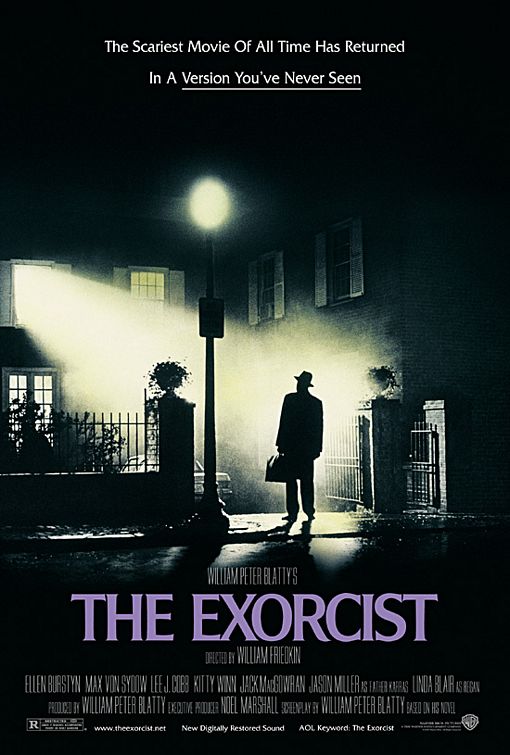 Last month, we ran a list of the American Film Institute’s nominees for the best Fantasy and Science-Fiction Films of all time. Many readers were angry over the exclusion of horror from the genres under consideration; some were unhappy about certain titles that made or did not make it onto the A.F.I.’s lists; a few were offended by our caustic comments about the more dubious inclusions. Well, we all have our favorites. Neither the A.F.I. nor Cinefantastique Online is the sole arbiter of what constitutes the best of the best in movie magic. Therefore, we thought it would be a good idea to present a gallery of expert opinions from people working behind the scenes. What films rank as favorites among industry insiders who made your favorite films? What films frightened or amazed the directors, writers, actors, and authors who make a living in the genres of science-fiction, fantasy, and horror? What films stirred their sense of wonder or made them want to make movies? You’ll find a sample of their answers below…
Last month, we ran a list of the American Film Institute’s nominees for the best Fantasy and Science-Fiction Films of all time. Many readers were angry over the exclusion of horror from the genres under consideration; some were unhappy about certain titles that made or did not make it onto the A.F.I.’s lists; a few were offended by our caustic comments about the more dubious inclusions. Well, we all have our favorites. Neither the A.F.I. nor Cinefantastique Online is the sole arbiter of what constitutes the best of the best in movie magic. Therefore, we thought it would be a good idea to present a gallery of expert opinions from people working behind the scenes. What films rank as favorites among industry insiders who made your favorite films? What films frightened or amazed the directors, writers, actors, and authors who make a living in the genres of science-fiction, fantasy, and horror? What films stirred their sense of wonder or made them want to make movies? You’ll find a sample of their answers below…
WILLIAM FRIEDKIN (Director of THE EXORCIST)
The horror films that I admire are ROSEMARY’S BABY, ALIEN, DIABOLIQUE, PSYCHO – that’s about it. I would say those are horror films, but they totally transcend the genre. They’re every bit as good as stories as horror films: the stories are believable; the characters are believable; the situations they’re put in, the style of performance, is believable. There’s also a Japanese film that I love called Onibaba, another wonderful film of fantasy and imagination, worked very carefully into a fairly realistic story. Whereas in something like Nightmare on Elm Street or Jason, it isn’t believable. There’s an automatic distance there—between what’s on the screen and the audience’s perception of real people in real situations.
I like THE BLAIR WITCH PROJECT. I applaud its ingenuity. It was something different, and it was pure to what it was—it did not break the focus. It was a documentary. When people set the camera down, all it showed you was shoes or sometimes nothing. I have to tell you, I sat there with my then fourteen-year-old son, and it scared the hell out of us. That picture scared me. I thought it was really good, because I love documentaries. I love that somebody took the horror genre, and did almost a pure documentary with it. I think Blair Witch is a helluva a film, a good film.
RIDLEY SCOTT (Director of ALIEN)
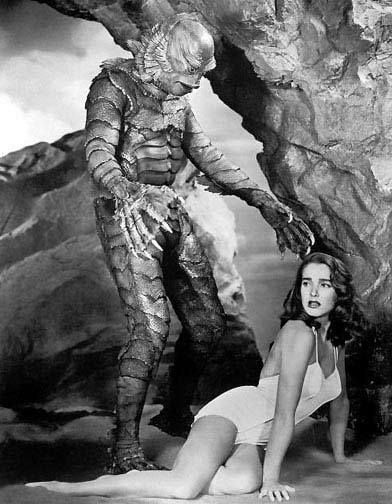 The thing I always worried about doing a monster movie—I was frightened that the monster wouldn’t be good, because they very rarely are. Probably the last great monster before that was the little girl in the bed in The Exorcist. But all you had to put on her was the voice—of Mercedes McCambridge—and that one trick was chilling. I decided to see THE CREATURE FROM THE BLACK LAGOON, THEM and IT [THE TERROR FROM BEYOND SPACE]—which actually were good fun at the time, used to scare the living daylights out of me as a kid, and now are kind of collector’s items. Funnily enough, as a child, I was always brought up not to see horror movies, because my parents classified them along with sex movies, so I wasn’t allowed to see them. I saw this poster in Piccadilly of this guy standing there with the face-mask on and the buzz saw, and I just decided not to see the film—that [The Texas Chainsaw Massacre ] was pretty tough stuff.
The thing I always worried about doing a monster movie—I was frightened that the monster wouldn’t be good, because they very rarely are. Probably the last great monster before that was the little girl in the bed in The Exorcist. But all you had to put on her was the voice—of Mercedes McCambridge—and that one trick was chilling. I decided to see THE CREATURE FROM THE BLACK LAGOON, THEM and IT [THE TERROR FROM BEYOND SPACE]—which actually were good fun at the time, used to scare the living daylights out of me as a kid, and now are kind of collector’s items. Funnily enough, as a child, I was always brought up not to see horror movies, because my parents classified them along with sex movies, so I wasn’t allowed to see them. I saw this poster in Piccadilly of this guy standing there with the face-mask on and the buzz saw, and I just decided not to see the film—that [The Texas Chainsaw Massacre ] was pretty tough stuff.
DIRECTOR GEORGE A ROMERO (Director of NIGHT OF THE LIVING DEAD and MARTIN)
Martin is my all-time favorite. When you make films, it’s hard to decide which among them is your favorite. When and if you make a choice, there are many factors that go into it—the experience, memories of the people working with you. On that film I had my first chance to work with Tom Savini, John Amplas. The crew numbered fifteen, including the cast. We had no money. A handful of people made it possible for me to make the movie. We made it on spit and a prayer. I think it’s my most successful effort, in that it comes closer than anything I’ve done to what I intended when I wrote the script. It turned out almost exactly the way I originally envisioned it.
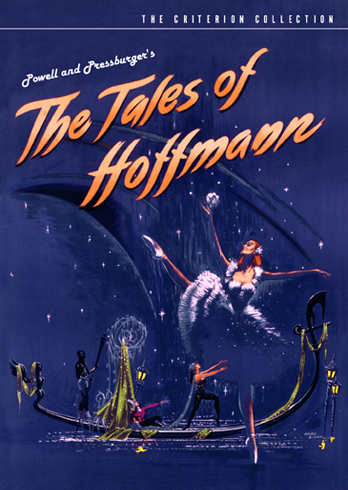 I read my share of Poe. I collected EC Comics, and I’m old enough to have seen FRANKENSTEIN and DRACULA on the big screen—when they were re-released. I’m not that old! I saw THE THING FROM ANOTHER WORLD in its first run, also on the big screen The movie that made me want to make movies is—you’ll probably be surprised by this—is The Tales of Hoffman, an adaptation of Orfenbach’s opera. It’s sung in English, but the words don’t matter much; it’s the imagery that grabs you, and it never lets go. I was one of the few who saw this particular film when it played in a theatre on a big screen and in color. The film has action and adventure, and it was way serious to an eleven year old. It was released in the same year as The Thing from Another World—big competition—but this film made more of an impression than James Arness ever could. I love some of Dario Argento’s early ones, Deep Red and The Bird with the Crystal Plumage. Those were probably my favorites, and Suspiria—it’s operatic and beautiful—like The Tales of Hoffman. Repulsion is the most frightening film that I’ve ever seen. Lapsed Catholics—not practicing Catholics, but those who have strayed—like me—stained our jockeys when we first saw The Exorcist. As far as I’m concerned, that is the only film that dealt with Pure Evil and managed to pull it off.
I read my share of Poe. I collected EC Comics, and I’m old enough to have seen FRANKENSTEIN and DRACULA on the big screen—when they were re-released. I’m not that old! I saw THE THING FROM ANOTHER WORLD in its first run, also on the big screen The movie that made me want to make movies is—you’ll probably be surprised by this—is The Tales of Hoffman, an adaptation of Orfenbach’s opera. It’s sung in English, but the words don’t matter much; it’s the imagery that grabs you, and it never lets go. I was one of the few who saw this particular film when it played in a theatre on a big screen and in color. The film has action and adventure, and it was way serious to an eleven year old. It was released in the same year as The Thing from Another World—big competition—but this film made more of an impression than James Arness ever could. I love some of Dario Argento’s early ones, Deep Red and The Bird with the Crystal Plumage. Those were probably my favorites, and Suspiria—it’s operatic and beautiful—like The Tales of Hoffman. Repulsion is the most frightening film that I’ve ever seen. Lapsed Catholics—not practicing Catholics, but those who have strayed—like me—stained our jockeys when we first saw The Exorcist. As far as I’m concerned, that is the only film that dealt with Pure Evil and managed to pull it off.
GUILLERMO DEL TORO (Director of PAN’S LABYRINTH)
My favorites of my own films are PAN’S LABYRINTH, THE DEVIL’S BACKBONE, and HELLBOY.
I started watching horror films without caring much about their origin. We got some Mario Bava films. Of course, we have the Mexican wrestler/masked avengers type of horror film. Then every Sunday there was a local channel that showed all the Universal monster movies: everything from the classics Frankenstein to Bride of Frankenstein and so forth. Then at the matinee, my mother took me to see the Hammer films: DRACULA, HORROR OF FRANKENSTEIN, all of them. So I really got every single thing on the spectrum fed into my brain at this very tender age.
TAKASHI SHIMIZU (Director of THE GRUDGE)
I am influenced by lots of filmmakers and movies, so it’s hard to name everything. I like art films like Decalogue and big-budget Hollywood movies like SPIDER-MAN 2, but I fell asleep in SPIDER-MAN. Sorry, Sam! (referring to SPIDER-MAN director Sam Raimi, who produced THE GRUDGE)
SCOTT DERRICKSON (Director of THE EXORCISM OF EMILY ROSE)
In cinema, you have to be crazy [to make an exorcism film] after THE EXORCIST. It’s my favorite horror film; I think it’s the best horror film ever made. You’re not going to make a better movie than that. People who tried to imitate that movie have pretty notoriously failed. It’s daunting.
ADAM GREEN (Writer-director of HATCHET, whose festival tag-line was: “It’s not a remake; it’s not a sequel; and it’s not based on a Japanese one.’)
In fact I like Japanese horror films, and some of my favorite films are remakes. John Carpenter’s THE THING is my Top Five of all time, and I love THE TEXAS CHAINSAW MASSACRE [remake] – as much as a lot of people would want to kill me for saying that. I wanted to hate that when I saw it, and I really liked it. Even the second time – because I thought, ‘Maybe it’s just Jessica Biel’s boobs,’ but it wasn’t; it was really that good.
HALLOWEEN to me is still [great] – nothing will ever touch that one. [Slasher films] created villains with great mythologies behind them that were very simple stories that you could easily explain to your friend while you’re lying on the floor in sleeping bags at night, having a sleepover. That was the real joy of these films for me. The villains were these anti-superheroes; they were just these total bad-asses. As much as you were afraid of them, you were kind of rooting for them because they were so cool.
WILLIAM MALONE (Director of THE HOUSE ON HAUNTED HILL)
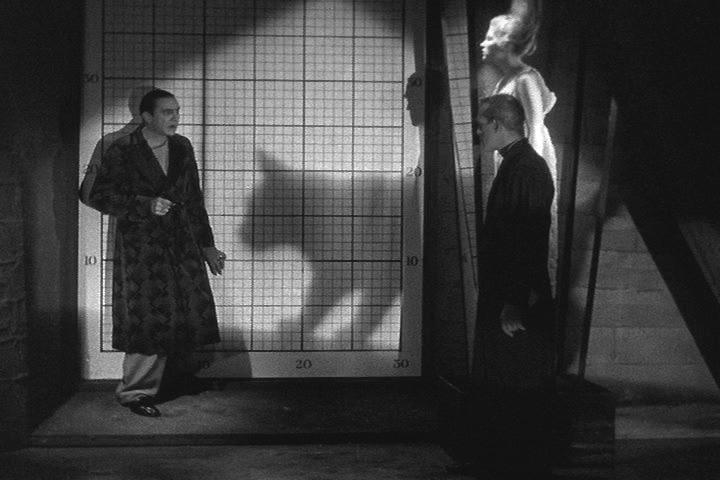 Of recent ilk, one of my favorites was ALIEN, which is just a brilliant movie. I still love CREATURE FROM THE BLACK LAGOON: there’s something evocative about it that really works. I love things like THE CABINET OF DR. CALIGARI and FRANKENSTEIN, which is a wonderful picture; the original still really holds up. MAD LOVE is a really cool movie, with Peter Lorre. And some other stuff has been overlooked like PLANET OF THE VAMPIRES, the Mario Bava picture, which I think is a wonderful film. I was heavily influenced by THE BLACK CAT [1934], which is one of my favorite films. I love that movie. When I first met Geoffrey [Rush, whom Malone directed in House], he’d just gone to see THE BLACK CAT, and he talked about how much he loved it. It’s got this perversity, this weird, dark undertone. What’s great about it is that you can’t put your finger on it, except if you actually look at the plot of that movie, you could never do that today. It’s too twisted: the fact that Karloff kills Lugosi’s wife and then keeps her body preserved in the basement, and then marries her daughter! I’m a big fan of [director Edgar G.] Ulmer’s work.
Of recent ilk, one of my favorites was ALIEN, which is just a brilliant movie. I still love CREATURE FROM THE BLACK LAGOON: there’s something evocative about it that really works. I love things like THE CABINET OF DR. CALIGARI and FRANKENSTEIN, which is a wonderful picture; the original still really holds up. MAD LOVE is a really cool movie, with Peter Lorre. And some other stuff has been overlooked like PLANET OF THE VAMPIRES, the Mario Bava picture, which I think is a wonderful film. I was heavily influenced by THE BLACK CAT [1934], which is one of my favorite films. I love that movie. When I first met Geoffrey [Rush, whom Malone directed in House], he’d just gone to see THE BLACK CAT, and he talked about how much he loved it. It’s got this perversity, this weird, dark undertone. What’s great about it is that you can’t put your finger on it, except if you actually look at the plot of that movie, you could never do that today. It’s too twisted: the fact that Karloff kills Lugosi’s wife and then keeps her body preserved in the basement, and then marries her daughter! I’m a big fan of [director Edgar G.] Ulmer’s work.
JEAN-PIERRE JEUNET (Director of ALIEN: RESURRECTION and AMALIE)
I love American Beauty, Memento, Happiness. I have two films in my life: A CLOCKWORK ORANGE from Stanley Kubrick and ONCE UPON A TIME IN THE WEST. I saw it when I was a teen, and I couldn’t eat or sleep for three days. My parents were, “What? What? Are you sick?” “No no, you can’t understand!”
MAZAAKI TEZUKA (Director of GODZILLA: TOKYO S.O.S.)
The first GODZILLA (1954) … [is] a masterpiece, but KING KONG VS. GODZILLA is my favorite.
ROLFE KANEFSKY (Writer-director of NIGHTMARE MAN)
I saw Frankenstein and all the monster movies when I was four years old, but I became a huge horror fan when I was fourteen, when I really started watching horror films and seeing all the conventions and the clichés. All the really good horror films were – except when the studios decided to stay out of it, like THE EXORCSIT – they were not studio films. They were independent films: HALLOWEEN, FRIDAY THE 13TH, A NIGHTMARE ON ELM STREET.
LEONARD WOLF (Author of Dracula: A Connoisseurs Guide)
I am very drawn, curiously enough, to the silent film, NOSFERATU (1922). When Count Orlock comes to—her name is either Nina or Ellen, depending on the subtitles—they exchange looks across the areaway. It is so charged with complex implications. Clearly, he is now going to be in the role of the demon lover, making love to a woman who sends her husband away—it’s got elements of French comedy in it. At the same time it’s a ghoulish moment, when this guy who’s not really living shows up in her bedroom and crouches at the side of her bed. You never know what they’re doing, but whatever they’re doing is so silent and so horrible and so Christian and so appalling—I’ve said somewhere in my book that the silence is intensified. We know we’re in a silent film, but somehow that scene takes on a terror because it’s so utterly still.
SUZY MCKEE CHARNAS (Author of The Vampire Tapestry)
I think that one thing that happens when you are raised as a reader rather than a visual consumer is that when you do go to films, they’re really pretty overwhelming. I remember being really impressed by silly things like ABBOTT AND COSTELLO MEET FRANKENSTEIN. It is wonderful, but it shouldn’t send you screaming! It did influence me, to put it mildly. For a very long time, the whole vampire thing was very tightly attached to the Hungarian actor whose name we all know. I still kind of balk when people get too far away from a basic sort of dignity. I don’t really go for BUFFY THE VAMPIRE SLAYER-type of vampires, and the punk rocker ones really turn me off.
BARBARA STEEL (Star of BLACK SUNDAY, a.k.a. Mask of the Demon)
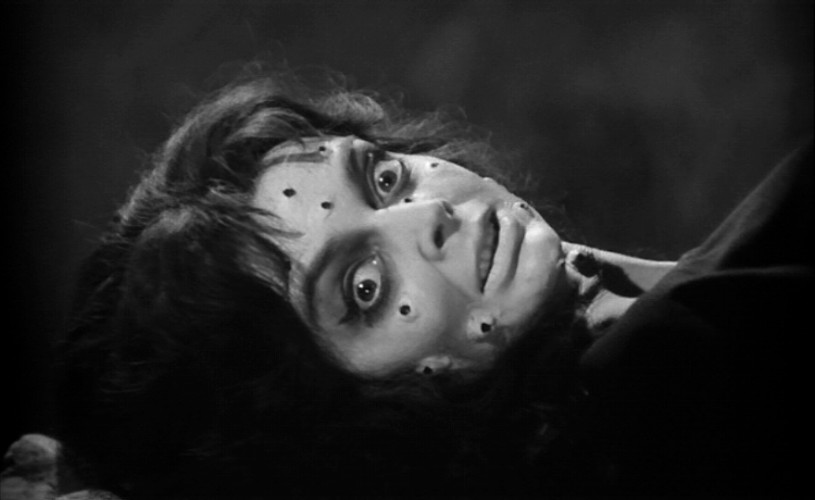 Black Sunday is the best of the genre films I made—the final result was most perfected in terms of the whole film, but I don’t feel it was best for me as an actress. I never saw a completed script for BLACK SUNDAY. We were given the pages day to day. We had hardly any idea of what was ever going down on that film. We had no idea of the end or the beginning, either. I’m sure he [director Mario Bava] had, or maybe he hadn’t. He really geared it to play out all his cinematographic-visual fantasies, and I think that one of the strongest points of the movie is the look of it. It’s just fortuitous for an actress to find herself in something that well structured.
Black Sunday is the best of the genre films I made—the final result was most perfected in terms of the whole film, but I don’t feel it was best for me as an actress. I never saw a completed script for BLACK SUNDAY. We were given the pages day to day. We had hardly any idea of what was ever going down on that film. We had no idea of the end or the beginning, either. I’m sure he [director Mario Bava] had, or maybe he hadn’t. He really geared it to play out all his cinematographic-visual fantasies, and I think that one of the strongest points of the movie is the look of it. It’s just fortuitous for an actress to find herself in something that well structured.
CHRISTINA RICCI (star of SLEEPY HOLLOW)
I’ve always loved [Tim Burton’s] movies. EDWARD SCISSORHANDS is one of my favorite movies of all time. His movies are so different. His movies are so beautiful and really elegant. They’re also told with such an innocence and a goodness. People say his movies are dark, but they’re really about Good and Evil, and the Good is always so good and so strong—they’re actually really sweet stories.
PATRICK MACNEE (Star of THE HOWLING)
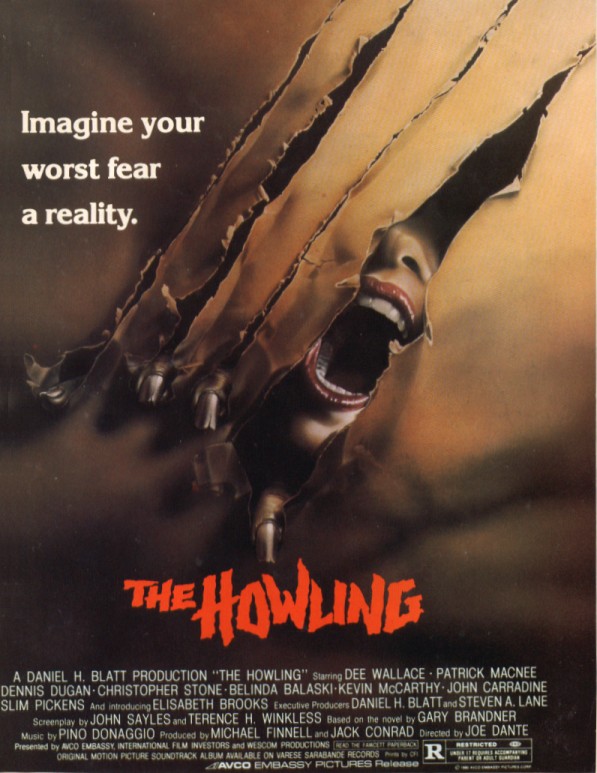 You just can’t get a more stunning film. My darling wife and my friends sat there watching it like that [grips the armrest of his chair and forms his mouth into a silent scream to demonstrate]. It’s a wonderful, wonderful film. Now all my other films— THE CREATURE WASN’T NICE, LOBSTER MAN FROM MARS —I have been in more movies of that type. I’m not saying we weren’t good in them, but they were movies you never see again, hopefully. When Dennis Bartok [of American Cinematheque] said, ‘We’re going to do a retrospective of your movies,’ I said, ‘Which one? There’s only one worth seeing, and this is it!’
You just can’t get a more stunning film. My darling wife and my friends sat there watching it like that [grips the armrest of his chair and forms his mouth into a silent scream to demonstrate]. It’s a wonderful, wonderful film. Now all my other films— THE CREATURE WASN’T NICE, LOBSTER MAN FROM MARS —I have been in more movies of that type. I’m not saying we weren’t good in them, but they were movies you never see again, hopefully. When Dennis Bartok [of American Cinematheque] said, ‘We’re going to do a retrospective of your movies,’ I said, ‘Which one? There’s only one worth seeing, and this is it!’
JOE DANTE (Director of THE HOWLING)
There are too many monster movies for me to pick. I spent a misspent youth watching monster movies, and then I spent a misspent adulthood making them. So I would refer you to any list of decent monster movies, and I’m sure my favorites will be on there.
